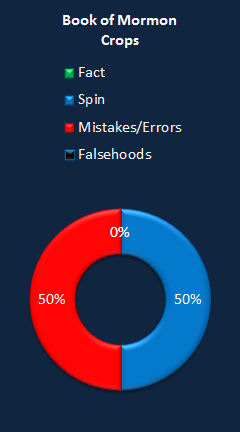
FAIR is a non-profit organization dedicated to providing well-documented answers to criticisms of the doctrine, practice, and history of The Church of Jesus Christ of Latter-day Saints.
FAIR Answers—back to home page
| Book of Mormon Animals | A FAIR Analysis of: Difficult Questions for Mormons, a work by author: The Interactive Bible
|
Book of Mormon Geography |
| Claim Evaluation |
| Difficult Questions for Mormons |

|
Response to claim: "Why is plow agriculture such as Barley (Alma 11:7) and Wheat (Mosiah 9:9) included in the Book of Mormon when it didn't exist during that time period? "There's a whole system of production of wheat and barley . . . It's a specialized production of food. You have to know something to make flax [the source of linen], and especially in tropical climates. Grapes and olives . . . all these are cultures that are highly developed and amount to systems, and so the Book of Mormon is saying that these systems existed here." (BYU anthropology professor, Dr. Raymond T. Matheny, August 25, 1984 Sunstone conference in Salt Lake City). Welch claims barley existed in the Book of Mormon based on one find in Phoenix, Arizona! Arizona is hardly the setting of the Book of Mormon."
Pre-Columbian New World barley was first reported in the scientific literature in 1983.
The December 1983 issue of the popular magazine Science 83 reported the discovery in Phoenix, Arizona, by professional archaeologists of what they supposed to be pre-Columbian domesticated barley. That same month, F.A.R.M.S. carried a preliminary notice of the discovery. This Arizona find is the first direct New World evidence for cultivated pre-Columbian barley in support of the Book of Mormon. Mosiah 9:9 lists barley among several crops that were cultivated by the Nephites in the land of Nephi, and Alma 11:7 singles out barley as the primary grain into which silver and gold were converted in the Nephite system of weights and measures.
That there are copious samples of cultivated barley at pre-Columbian sites in Arizona seemed a first for the Western Hemisphere, but Professor Howard C. Stutz of the BYU Department of Biology tells us that three types of wild barley have long been known to be native to the Americas. The real surprise is that this barley is of a cultivated ("naked") type, although the ethnobotanist for the Arizona project, Dr. Vorsila Bohrer (Eastern New Mexico University, Portales), says that it is not yet clear whether the samples were truly naked (unhulled) or simply naturally degraded in context.[1]
Response to claim: "Why aren't the foods known to ancient America such as chocolate, lima beans, squash, potatoes, tomatoes, manioc, etc. included in the Book of Mormon?"
Notes

FAIR is a non-profit organization dedicated to providing well-documented answers to criticisms of the doctrine, practice, and history of The Church of Jesus Christ of Latter-day Saints.
We are a volunteer organization. We invite you to give back.
Donate Now